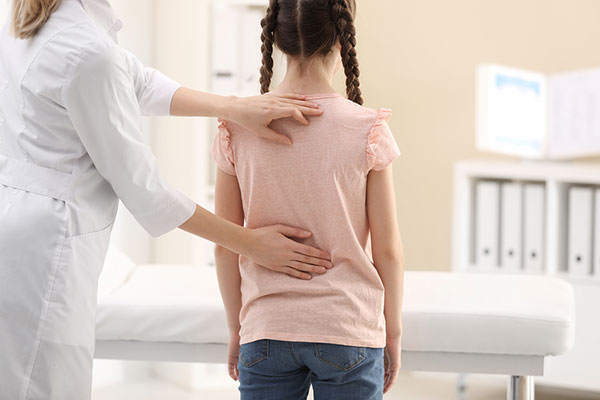
Back Pain in Kids: A Surprisingly Common Problem

How many times have you or someone you know complained of back pain? It’s one of the most common reasons adults go to the doctor. You might be surprised to learn that a significant number of children and teens experience back pain too.
A recent study at HSS found that one in three young people ages 10 to 18 had experienced back pain during the previous year. The research, presented this year at the American Academy of Orthopaedic Surgeons annual meeting, is one of few studies looking at back pain in a younger population.
"Back pain is actually very common in children and adolescents, and we found that it increases with age," says Peter Fabricant, MD, MPH, an HSS pediatric sports medicine specialist who presented the study. "Only about 40% seek any kind of treatment, and the vast majority don't require anything more than physical therapy. Many get better with rest. Very few require injections or surgery."
Dr. Fabricant and colleagues at HSS surveyed 3,669 young people from across the country, representative of the U.S. population, with equal numbers of male and female participants. Of the third of respondents who reported experiencing a backache, only 9% indicated it was severe. Other findings from the study:
- girls suffered from back pain more often
- lower back pain was most common
- incidence of back pain increased as kids got older
- those who were more athletic, especially those participating in sports at a high level, reported the most pain
What are common causes of back pain in kids?
Shevaun Doyle, MD, a pediatric orthopedic surgeon at Lerner Children’s Pavilion who treats many children and adolescents with back pain, says her patients often have pain caused by:
- Overuse. This type of injury occurs from overdoing it while playing a sport. Repeating the same movements over and over again puts stress on the back.
- Not stretching or warming up. Kids who forgo a proper warm-up before a sport are also more susceptible to hurting their back, Dr. Doyle says.
- Doing too much, too soon. Those who jump into an activity before they are fit enough to play the sport are at greater risk of injury as well.
- Hyperextension. Sports that require hyperextension (excessive movement of the joint beyond a normal range of motion), such as gymnastics, soccer and diving, also lead to more back injuries.
Dr. Doyle says parents should take all complaints of pain seriously, although it isn’t always necessary to see a doctor right away. “As long as the pain is contained to the back, not radiating into the arms or legs or causing headaches, and not disrupting sleep, it’s reasonable to try a little rest, take a break from the sport and try an over-the-counter anti-inflammatory to see if the pain improves,” she says. “However, if the pain persists longer than three days, gets progressively worse, or makes it difficult to complete activities of daily living, then it should be evaluated by a doctor.”
Another reason to see a doctor sooner rather than later would be if a backache is related to a specific injury, or if there is a particular activity, such as serving a tennis ball, that triggers the pain, Dr. Doyle notes. Conservative treatments such as physical therapy often help for a backache arising from an injury or overuse. Young people rarely need surgery.
What are signs of a serious back condition?
In very young children, back pain should never be ignored, Dr. Doyle says. Signs of a serious condition, such as an infection or other problem, in young people of all ages include:
- fever or weight loss
- weakness or numbness
- trouble walking
- pain that radiates down one or both legs
- bowel or bladder problems
- pain that keeps the child awake at night
Tips to avoid back pain
Dr. Doyle has the following recommendations to help young people stay strong and avoid back pain:
- Do exercises such as sit-ups and planks to strengthen the core.
- Make sure to warm up and stretch properly when playing a sport.
- Maintain good form when exercising or playing a sport.
- Bend the knees, not from the waist, when lifting a heavy package.
The HSS study also found that lugging around a backpack played a role in causing back pain. Kids who used one strap to carry their packs reported significantly more pain than those who used both straps.
John Blanco, MD, a pediatric orthopedic surgeon at HSS, says good practices are important when using a backpack. He offers the following tips for parents:
- Invest in a sturdy backpack with wide, padded shoulder straps and a padded back.
- Encourage kids to always wear the backpack on both shoulders.
- Tighten the shoulder straps so the backpack is close to the body to put less strain on the back.
- Purchase a backpack with a strap that goes around the waist and encourage kids to use it. This helps distribute the weight more evenly.
- Organize the backpack to make the best use of compartments. Heavier items should be packed closest to the middle of the bag.
The American Academy of Pediatrics advises that backpacks should weigh no more than 10 to 20% of a child’s body weight. Dr. Blanco also recommends that students check their backpack every day before heading to school, or the evening before, and take out extra books or supplies they won’t need.

